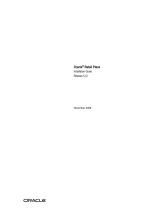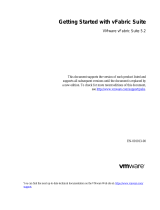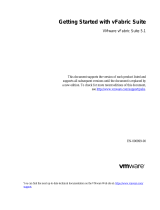Page is loading ...

Oracle Unified Messaging
Installation Guide
Release 2.1.2 for Sun SPARC Solaris 2.6
January, 2001
Part No. A86091-02

Unified Messaging Installation Guide, Release 2.1.2 for Sun SPARC Solaris 2.6
Part No. A86091-02
Copyright © 1996, 2001 Oracle Corporation. All rights reserved.
Primary Author: Ginger Tabora
Contributors: Byung Choung, Varouzhan Ebrahimian, Duane Jensen, Tom Kraikit, Jae Lee, Sunia Lin,
Allen Liu, Louise Luo, Stefano Montero, Howard Narvaez, Ricardo Rivera
The Programs (which include both the software and documentation) contain proprietary information of
Oracle Corporation; they are provided under a license agreement containing restrictions on use and
disclosure and are also protected by copyright, patent, and other intellectual and industrial property
laws. Reverse engineering, disassembly, or decompilation of the Programs is prohibited.
The information contained in this document is subject to change without notice. If you find any problems
in the documentation, please report them to us in writing. Oracle Corporation does not warrant that this
document is error free. Except as may be expressly permitted in your license agreement for these
Programs, no part of these Programs may be reproduced or transmitted in any form or by any means,
electronic or mechanical, for any purpose, without the express written permission of Oracle Corporation.
If the Programs are delivered to the U.S. Government or anyone licensing or using the programs on
behalf of the U.S. Government, the following notice is applicable:
Restricted Rights Notice Programs delivered subject to the DOD FAR Supplement are "commercial
computer software" and use, duplication, and disclosure of the Programs, including documentation,
shall be subject to the licensing restrictions set forth in the applicable Oracle license agreement.
Otherwise, Programs delivered subject to the Federal Acquisition Regulations are "restricted computer
software" and use, duplication, and disclosure of the Programs shall be subject to the restrictions in FAR
52.227-19, Commercial Computer Software - Restricted Rights (June, 1987). Oracle Corporation, 500
Oracle Parkway, Redwood City, CA 94065.
The Programs are not intended for use in any nuclear, aviation, mass transit, medical, or other inherently
dangerous applications. It shall be the licensee's responsibility to take all appropriate fail-safe, backup,
redundancy, and other measures to ensure the safe use of such applications if the Programs are used for
such purposes, and Oracle Corporation disclaims liability for any damages caused by such use of the
Programs.
Oracle is a registered trademark, and Oracle Names, and Oracle Office are trademarks or registered
trademarks of Oracle Corporation. Other names mentioned may be trademarks of their respective
owners.

iii
Contents
Preface........................................................................................................................................................... vii
1 Preinstallation
Installation Overview........................................................................................................................ 1-2
Installation Requirements ................................................................................................................ 1-2
System Requirements................................................................................................................... 1-2
Software Requirements................................................................................................................ 1-3
Preinstallation Tasks.......................................................................................................................... 1-3
Task 1: Back Up and Shut down Existing Database and Log Files....................................... 1-4
Task 2: Install and Configure the Oracle8 Universal Data Server......................................... 1-4
Task 3: Start the Processes Necessary for Installation............................................................. 1-4
Task 4: Configure Net8 (Database Node Installation) TNSLISTENER80 ............................ 1-5
Task 5: Configure Net8 (Multiple Instance Installations Only)............................................. 1-6
2 Installing and Configuring Oracle Unified Messaging
Installing Oracle Unified Messaging.............................................................................................. 2-2
Mounting the Product CD-ROM Manually........................................................................... 2-2
Running the Oracle Universal Installer.................................................................................. 2-2
Entering File Locations................................................................................................................ 2-5
Verifying Your Installation Settings .......................................................................................... 2-7
Starting the Configuration Assistant Manually................................................................ 2-9
Configuration Assistant Screen Buttons .......................................................................... 2-10
Specifying File Locations........................................................................................................... 2-11
Entering Passwords.................................................................................................................... 2-13

iv
Specifying Oracle eMail Server Parameters............................................................................ 2-15
Specifying Oracle eMail Server Passwords............................................................................. 2-15
Entering LDAP Information...................................................................................................... 2-16
Exiting the Configuration Assistant......................................................................................... 2-19
3 Post Installation
Post Installation Tasks ....................................................................................................................... 3-2
Task 1: Create the Oracle Unified Messaging LDAP Schema................................................ 3-2
Task 2: Encoding the Helpdesk Password................................................................................ 3-3
Task 3: Configuring the oomgr RMI Process............................................................................ 3-4
Task 4: Starting the Oracle Unified Messaging Processes ...................................................... 3-4
Task 5: Configuring Apache Listener Port................................................................................ 3-4
Task 6: Configuring JServ............................................................................................................ 3-5
Task 7: Starting Apache JServ..................................................................................................... 3-5
Task 8: Configuring HelpDesk ................................................................................................... 3-5
Task 9: Updating Real Audio (only if Real Audio is installed).............................................. 3-6
Task 10: Updating the Tiff to Gif Executable (only if a Tiff to Gif executable is installed) 3-6
4 Troubleshooting
Log Files and Trace Files.................................................................................................................... 4-2
Troubleshooting Hints....................................................................................................................... 4-2

v
Send Us Your Comments
Oracle Unified Messaging Installation Guide, Release 2.1.2 for Sun SPARC Solaris 2.6
Part No. A86091-02
Oracle Corporation welcomes your comments and suggestions on the quality and usefulness of this
publication. Your input is an important part of the information used for revision.
■ Did you find any errors?
■ Is the information clearly presented?
■ Do you need more information? If so, where?
■ Are the examples correct? Do you need more examples?
■ What features did you like most about this manual?
If you find any errors or have any other suggestions for improvement, please indicate the chapter,
section, and page number (if available). You can send comments to us in the following ways:
■ Electronic mail: [email protected]
■ FAX: (650) 506-7228 Attn: Unified Messaging Documentation Manager
■ Postal service:
Oracle Corporation
Unified Messaging Documentation Manager
500 Oracle Parkway, Mailstop 4OP12
Redwood Shores, CA 94065
USA
If you would like a reply, please give your name, address, and telephone number below.
If you have problems with the software, please contact your local Oracle Support Services representa-
tive.

vi

vii
Preface
The topics covered in this preface include:
■ Intended Audience
■ Oracle Unified Messaging Documentation
■ Related Documents
■ Notation Conventions

viii Installation Guide
Intended Audience
The configuration and installation instructions in this document are intended for
anyone who is responsible for installing Oracle products on Sun SPARC Solaris.
While some command examples are provided, this document does not attempt to
teach Oracle or UNIX administration.
Oracle Unified Messaging Documentation
Oracle Unified Messaging documentation is available in HTML and PDF format on
the CD-ROM and installs automatically during product installation. Use your Web
browser to access $ORACLE_HOME/um/doc/index.html on your server. The following
documents are available:
Related Documents
This guide provides operating system-specific information for Oracle Unified
Messaging for Sun SPARC Solaris 2.6. This document refers to the following user
guides and reference manuals:
■ Oracle eMail Server 5.1 Installation Guide
■ Oracle eMail Server 5.1 Administration Guide
■ Oracle eMail Server 5.1 Release Notes
■ Oracle Internet Application Server 8i Installation Guide Release 1.0 for Sun SPARC
Solaris
Ordering Related Documentation
To order documentation, call the appropriate number listed below.
■ In the United States, call Documentation Sales at: 1-800-252-0303.
■ In the United Kingdom, call Oracle Direct Response at: +44-990-332200.
■ In other European countries, contact your local Oracle Support office.
■ In the Asia-Pacific region, contact your Oracle sales representative.
Oracle Unified Messaging Installation Guide
Oracle Unified Messaging Client Developer’s Guide
Oracle Unified Messaging Release Notes

ix
Notation Conventions
The following notational conventions appear in this manual:
Convention Description
italic Italicized type identifies document titles.
Monospace Monospace type indicates commands.
bold Boldface type indicates script names, directory names, path names,
and file names (for example, the root.sh script).
UPPERCASE Uppercase letters indicate parameters or environment variables (for
example, ORACLE_HOME).
.
.
.
In code examples, vertical ellipsis points indicate that information
not directly related to the example has been omitted.
. . . In command syntax, horizontal ellipsis points indicate repetition of
the preceding parameters. The following command example
indicates that more than one input_file may be specified on the
command line.
command [input_file ...]
< >
In command syntax, angle brackets identify variables that the user
must supply. You do not type the angle brackets. The following
command example indicates that the user must enter a value for the
variable input_file:
command <input_file>
[ ]
In command syntax, brackets enclose optional clauses from which
you can choose one or none. You do not type the brackets. The
following command example indicates that the variable output_file
is optional:
command <input_file> [output_file]
{ }
In command syntax, curly brackets indicate that a choice of two or
more items separated by a vertical bar or pipe ( | ). You do not type
the curly brackets. The following command example indicates a
choice of either a or b:
command {a | b}
$
The dollar sign represents the shell prompt in UNIX.

x Installation Guide

Preinstallation 1-1
1
Preinstallation
This chapter describes the preinstallation procedures for Oracle Unified Messaging.
Topics covered include:
■ Installation Overview
■ Installation Requirements
■ Preinstallation Tasks

Installation Overview
1-2 Installation Guide
Installation Overview
Oracle Unified Messaging is a highly scalable, messaging framework which
integrates messages from multiple sources into a single inbox. Prior to installation,
you should plan your implementation strategy and be familiar with Unified
Messaging system components, concepts, and terminology described in the Unified
Messaging Client Developer’s Guide.
The installation process is composed of the following steps:
1. Complete the necessary pre-installation tasks including backing up your
existing system, configuring the UNIX environment, and preparing related
processes and products for the installation.
2. Use the Installer on the Oracle software CD to install or upgrade Oracle Unified
Messaging and related software products.
3. Perform the post installation steps.
4. Verify the configuration by starting processes and checking process logs.
Installation Requirements
You must meet the following system and software requirements to install Oracle
Unified Messaging.
System Requirements
■ 50 MB of disk space
■ 128 MB of memory
Software Requirements
Oracle Unified Messaging requires the following software components and
associated versions:
Software
Components Version Comments
State During Unified
Messaging Installation
Oracle eMail Server 5.2 Installed and running
Oracle8i Data Server 8.1.7 Installed and running

Installation Requirements
Preinstallation 1-3
Oracle Internet
Directory
2.1.1 Installed and running
Oracle Internet
Application Server
(Oracle HTTP Server)
1.0.2.1 Required for Web
node only.
Oracle Internet
Application Server
cannot share the same
ORACLE_HOME
with other Oracle
products. If you have
installed other Oracle
products, then Oracle
Internet Application
Server must be
installed in a different
ORACLE_HOME.
Installed and running
Netscape
Communicator
Or:
Microsoft Internet
Explorer
JavaScript-enabled
browser
4.6 or 4.7
5.0.x
Either one installed
Real Audio Server
(optional)
5.0 Required for real
audio streaming.
Installed and running
Tiff to Gif Conversion
Tool (optional)
Required if your fax
server captures
images in .tiff format.
Installed and running
Software
Components Version Comments
State During Unified
Messaging Installation

Preinstallation Tasks
1-4 Installation Guide
Preinstallation Tasks
The following tasks must be performed prior to installing Oracle Unified
Messaging:
Task 1: Back Up and Shut down Existing Database and Log Files
Perform a full backup of your existing Oracle8 Universal Data Server before you
perform any new installation or upgrade. A full backup ensures that you can
recover from errors encountered during new installation or upgrade processes.
This backup should be taken with the database shut down cleanly. If you use SHUT
DOWN IMMEDIATE or SHUT DOWN ABORT to force users off the system, be
sure to restart the database in restricted mode, and then shut it down with normal
priority. See the Oracle8i Administrator’s Guide or Oracle8i Backup and Recovery for
more information.
Task 2: Install and Configure the Oracle8 Universal Data Server
Oracle Unified Messaging requires reconfiguration of specific database parameters.
Before starting this configuration, shut down the network listener and the database
where Oracle Unified Messaging will be installed.
To shut down the network listener:
$ lsnrctl stop
To shut down the database:
$ svrmgrl
SVRMGR> connect internal
Connected.
SVRMGR> shutdown
SVRMGR> exit
Edit the init
<sid>
.ora file located in the $ORACLE_HOME/dbs directory to
reflect the following minimum values for the listed parameters:
Parameter Minimum Settings
job_queue_processes 10
job_queue_interval 60

Preinstallation Tasks
Preinstallation 1-5
Task 3: Start the Processes Necessary for Installation
1. Start the database:
$ svrmgrl
SVRMGR> connect internal
Connected to an idle instance.
SVRMGR> startup
SVRMGR> exit
2.
Start the network listener:
$ lsnrctl start
Task 4: Configure Net8 (Database Node Installation) TNSLISTENER80
To install an Unified Messaging database node, a connect string must exist that
provides a connection to the Unified Messaging database using the sid.
1. Verify that the entry exists in the TNSNAMES.ORA file for the Unified Messaging
sid. If it does not exist, add the following:
<connect string> =
(DESCRIPTION=
(ADDRESS_LIST =
(ADDRESS = (PROTOCOL = tcp)
(HOST = <um host name>)
(PORT = <listener port>)
)
)
)
Example:
ORCL.world =
(DESCRIPTION=
(ADDRESS_LIST =
(ADDRESS = (community = tcp.world) (PROTOCOL =tcp)
(HOST = um.acme.com)
(PORT = 1521)
)
)
(CONNECT_DATA = (SERVICE_NAME = ORCL)
)
)

Preinstallation Tasks
1-6 Installation Guide
Task 5: Configure Net8 (Multiple Instance Installations Only)
If you are installing a separate Oracle Unified Messaging system from your Oracle
eMail Server database instance, then you must configure Net8 to enable the Oracle
Unified Messaging system to contact the Oracle eMail Server database.
1. Add the following entry for the Oracle eMail Server database system to which
you want to connect:
<connect string> =
(DESCRIPTION=
(ADDRESS=( PROTOCOL= TCP)(HOST= <ES host server name>)(PORT= 1521))
(CONNECT_DATA= (SERVICE_NAME= <ES sid>)))
Example
esnode1=
(DESCRIPTION =
(ADDRESS = (PROTOCOL= TCP) (HOST= eshardware.acme.com)(PORT=1521))
(CONNECT_DATA = (SERVICE_NAME= orcl)))
2.
Verify the modified tnsnames.ora file:
$ tnsping host
3. Verify that the Oracle eMail Server database tnsnames.ora file has an Oracle
Unified Messaging entry name that connects to the Oracle eMail Server
database instance.

Installing and Configuring Unified Messaging 2-1
2
Installing and Configuring Unified
Messaging
This chapter describes Unified Messaging installation and configuration procedures
for both new installations and upgrades. Topics covered include:
■ Installing Unified Messaging

Installing Unified Messaging
2-2 Installation Guide
Installing Unified Messaging
Mounting the Product CD-ROM Manually
The Oracle Product Installation CD-ROM is in RockRidge format. If you are using
the Solaris Volume Management software (installed by default on Sun SPARC
Solaris 2.x), the CD-ROM is mounted automatically when you put it into the disk
drive. If you are not using the Solaris Volume Management software, use the
following procedure to mount the CD-ROM manually. You must have root
privileges to mount or unmount the CD-ROM manually. Be sure to unmount the
CD-ROM before removing it from the drive.
1. Place the Product Installation CD-ROM in the CD-ROM drive.
2. Log in as the root user:
$ su root
3. Create a CD-ROM mount point directory:
# mkdir
mount_point_directory
4. Mount the CD-ROM drive on the mount point directory and exit the root
account:
# mount options
device_name mount_point_directory
# exit
Running the Oracle Universal Installer
1. Log in as the user who installed oracle products on this machine and change to
the installation directory on the CD-ROM:
$ cd /cdrom/cdrom0
2. Make sure the DISPLAY environment variable is set to your display address.
C Shell:
% setenv DISPLAY <hostname>:0.0
Bourne or Korn Shell:
$ DISPLAY=<hostname>:0.0;export DISPLAY

Installing Unified Messaging
Installing and Configuring Unified Messaging 2-3
3.
Make sure xhost, while physically located on the host machine, is set to enable
access to the X server on your machine. Use the following command:
% /usr/openwin/bin/xhost +
See the UNIX man pages for more information on xhost.
4. From the install directory on the CD-ROM, type the following command:
$ ./runInstaller
The ./runInstaller command launches the Oracle Universal Installer and the
Welcome dialog box displays.
Oracle Universal Installer Screen Buttons
This table gives you information about the Oracle Universal Installer screen
buttons.

Installing Unified Messaging
2-4 Installation Guide
Screen Button What it Does
Deinstall Products Takes you to the Deinstall screen.
About Oracle Universal Installer Gives you the version number.
Exit Exits you out of the install session.
Installed Products Shows you what Oracle products you have installed.
Previous Takes you back to the previous screen.
Next Takes you to the next screen.
Cancel Enables you to cancel the installation process.
/





